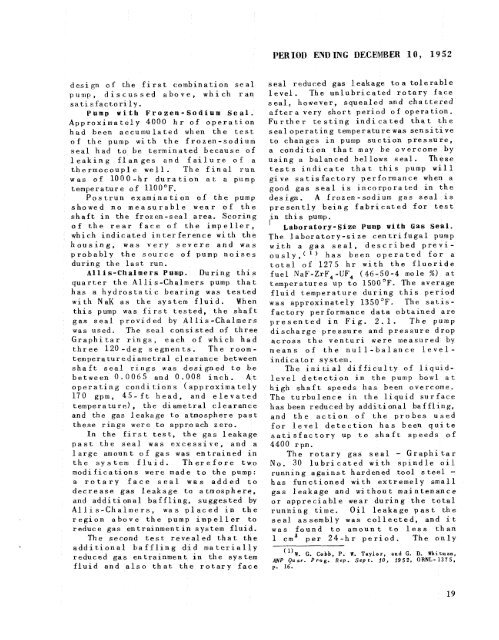the Molten Salt Energy Technologies Web Site
the Molten Salt Energy Technologies Web Site
the Molten Salt Energy Technologies Web Site
Create successful ePaper yourself
Turn your PDF publications into a flip-book with our unique Google optimized e-Paper software.
design of <strong>the</strong> first combination seal<br />
purrlp, discussed above, which ran<br />
sa t,i s fa c to ri 1 y .<br />
Pump with Frozen-Sodium Seal.<br />
Approximately 4000 hr of operation<br />
had been accumulated when <strong>the</strong> test<br />
of <strong>the</strong> pump with <strong>the</strong> frozen-sodium<br />
seal had to be terminated because of<br />
leaking flanges and failure of a<br />
<strong>the</strong>rmocouple well. The final run<br />
was of LOOO-hr duration at a pump<br />
temperature of 1P00'F.<br />
Postrun examination of <strong>the</strong> pump<br />
showed no measurable wear of <strong>the</strong><br />
shaft in <strong>the</strong> frozen-seal area. Scoring<br />
of <strong>the</strong> rear face of <strong>the</strong> impeller,<br />
which indicated interference with <strong>the</strong><br />
housing, was very severe and was<br />
probably <strong>the</strong> source of pump noises<br />
during <strong>the</strong> last run.<br />
Allis-Chalmers Pump. During this<br />
quarter <strong>the</strong> Allis-Chalmers pump that<br />
has a hydrostatic bearing was tested<br />
with NaK as <strong>the</strong> system fluid. When<br />
this pump was first tested, <strong>the</strong> shaft<br />
gas seal provided by Allis-Chalmers<br />
was used. The seal consisted of three<br />
Graphitar rings, each of which had<br />
three 120-deg segments. The room-<br />
temperature di ametral clearance between<br />
shaft seal rings was designed to be<br />
between 0.0065 and 0.008 inch. A t<br />
operating conditions (approximately<br />
170 gpm, 45-ft head, and elevated<br />
temperature), <strong>the</strong> diametral clearance<br />
and <strong>the</strong> gas leakage to atmosphere past<br />
<strong>the</strong>se rings were to approach zero.<br />
In <strong>the</strong> first test, <strong>the</strong> gas leakage<br />
past <strong>the</strong> seal was excessive, and a<br />
large amount of gas was entrained in<br />
<strong>the</strong> system fluid. Therefore two<br />
modifications were made to <strong>the</strong> pump:<br />
a rotary face seal was added to<br />
decrease gas leakage to a tmosphere,<br />
and additional baffling, suggested by<br />
Allis-Chalmcrs, was placed in <strong>the</strong><br />
region above <strong>the</strong> pump impeller to<br />
reduce gas entrainmentin system fluid.<br />
The second test revealed that <strong>the</strong><br />
additional baffling did materially<br />
reduced gas en trainmen t in <strong>the</strong> sys tern<br />
fluid and also that <strong>the</strong> rotary face<br />
PERIOD ENDING DECEMBER 10, I952<br />
seal reduced gas leakage toa tolerable<br />
level. The unlubricated rotary face<br />
seal, however, squealed and chattered<br />
aftera very short period of operation.<br />
Fur<strong>the</strong>r testing indicated that <strong>the</strong><br />
seal operating temperature was sensitive<br />
to changes in pump suction pressure,<br />
a condition that may be overcome by<br />
using a balanced bellows seal. These<br />
tests indicate that this pump w i l l<br />
give satisfactory performance when a<br />
good gas seal is incorporated in <strong>the</strong><br />
design. A frozen-sodium gas seal is<br />
presently being fabricated for test<br />
in this pump.<br />
' Laboratory-Size Pump with Gas Seal.<br />
The laboratory-size centrifugal pump<br />
with a gas seal, described previ-<br />
ously,(') has been operated for a<br />
total of 1275 hr with <strong>the</strong> fluoride<br />
fuel NaF-ZrF,-UF, (46-50-4 mole %) at<br />
temperatures up to 1500°F. The average<br />
fluid temperature during this period<br />
was approximately 1350°F. The satis-<br />
factory performance data obtained are<br />
presented in Fig. 2.1. The pump<br />
discharge pressure and pressure drop<br />
across <strong>the</strong> venturi were measured by<br />
means of <strong>the</strong> null-balance level-<br />
indicator system.<br />
The initial difficulty of liquid-<br />
level detection in <strong>the</strong> pump bowl at<br />
high shaft speeds has been overcome.<br />
The turbulence in <strong>the</strong> liquid surface<br />
has been reduced by additional baffling,<br />
and <strong>the</strong> action of <strong>the</strong> probes used<br />
for level detection has been quite<br />
satisfactory up to shaft speeds of<br />
4400 rpm.<br />
The rotary gas seal - Graphitar<br />
No. 30 lubricated with spindle oil<br />
running against hardened tool s tee1 -<br />
has functioned with extremely small<br />
gas leakage and without maintenance<br />
or appreciable wear during <strong>the</strong> total<br />
running time. Oil leakage past <strong>the</strong><br />
seal assembly was collected, and it<br />
was found to amount to less than<br />
1 cm3 per 24-hr period. The only<br />
(l)W. G. Cobb. P. W. Taylor, and G. D. Whitman,<br />
ANP Quar. Prog. Rep. Sept. IO, 1952. ORNL-1375,<br />
p. 16.<br />
19



![Review of Molten Salt Reactor Physics Calculations [Disc 2]](https://img.yumpu.com/21979492/1/190x247/review-of-molten-salt-reactor-physics-calculations-disc-2.jpg?quality=85)












